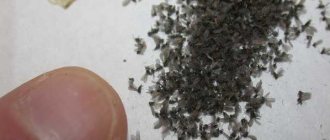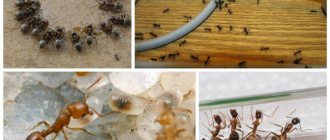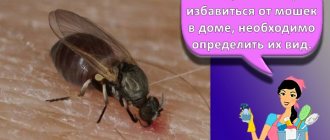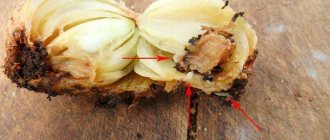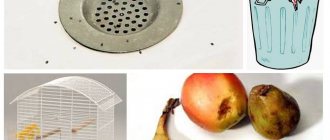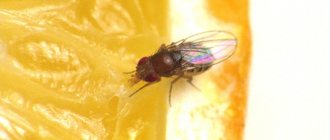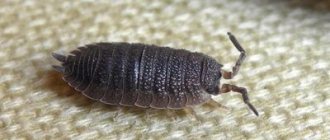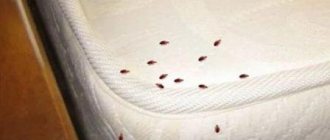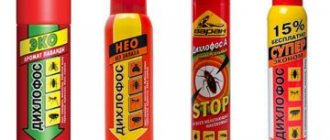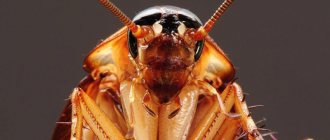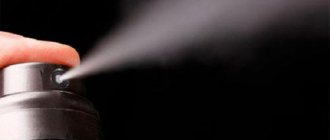Types of house midges, their differences and habitats
The food supply for small annoying insects that live in houses and apartments may be different, although they themselves are similar in appearance. Midges in an apartment look like a smaller copy of a fly or a very small mosquito with wings; they also belong to the class of insects (insecta), the order Diptera. The body length is 2–10 mm, there are three pairs of legs and one pair of wings.
Fruit fly (Drosophila melanogaster) is a species of the fruit fly family. Other names are fruit or wine midge , fruit fly . The body length is 2–4 mm. The color is red-yellowish, brown.
Butterflies are small flies whose body length reaches 1–4 mm. Externally they look like very small night moths. The body is covered with light brown fluff, and a pair of wings are covered with gray fibers. Other names for these insects are sewer flies or drain midges .
Sciarids or detritnits are small insects that belong to the family Sciaridae, the genera Sciara, Licoriella and Bradisia. Other names are leaf gnats , soil gnats or fungus gnats . The length of the graceful dark-colored body of Sciara ranges from 2 to 7 mm.
Drosophila feed on plant debris and fruit juice, so they are more often found in the kitchen, where they swarm over food waste. Sewer midges fly near the sink and drain hole in the bathroom. Sciarides usually climb around indoor plants, sit on flower pots, window sills, and window frames.
On balcony and indoor flowers you can find leafhoppers - representatives of the order Coleoptera, family Cicadellidae. These are larger insects than fruit flies and fungus gnats. The body length in the shape of the Latin letter V reaches 1 cm. The color is light gray, yellow, greenish. Adult leafhoppers can fly around the room, and at one stage of development they do not have wings and jump high near food plants.
The described species of house midges do not include true mosquitoes and flies; they are much larger. Screens on windows usually trap these insects, but are often useless against the smallest representatives of dipterans.
Kitchen
The most important rule is to never leave a trash bin overnight. The next steps will be:
Garbage bin in the kitchen with leftover vegetables
- monitor the freshness of products (prevent the formation of rot);
- It is recommended to use adhesive tape (both outside and inside cabinets);
- washcloths and washcloths should be twisted and dried after use;
- prevent the formation of fatty deposits and clogging of the drain pipe of the sink and hob;
- no leakage or contamination of taps;
- make homemade traps in the form of a cup with rotting fruit or unfinished juice (the area where a large number of midges get in, it must be tied tightly and thrown away).
What harm do midges cause?
Numerous midges in an apartment can appear suddenly, multiply quickly and greatly annoy people with their presence. The food supply of fruit flies is plant debris, including rotting parts of indoor plants. Sewer flies and fruit flies can infect food and various surfaces in the apartment.
On their legs and abdomen, insects carry pathogenic viruses, fungi and bacteria from trash cans and pipes.
Adult sciarids hardly feed. Females lay eggs on indoor plants and on the surface of the ground. Fungus gnat larvae are voracious and omnivorous. They live in earthen substrates, feed on soil fungi and plant debris, and if there is a lack of this food, they switch to eating roots and seedlings.
It is necessary to use all means and methods to get rid of midges at home and in the office. Adults and larvae suck out plant juices and inject their poisonous saliva. Midges carry infections (viral, bacterial, fungal), mites, and nematodes.
One adult female sciarid lays up to 300 eggs. If midges find an abundance of food in the apartment and do not meet resistance from the owners, they multiply very quickly. Fighting these insects is not an easy task, because they hide well and increase their numbers many times over in a short period of time.
Life cycle
The lifespan of these insects depends on the availability of food and air temperature. On average, life expectancy is 2 weeks in the presence of food and a temperature of about 18°; if the air temperature is 25°, life expectancy is reduced to 10 days.
Unfavorable conditions are air temperatures below 18°; the lower, the shorter the duration. A midge can only live for a few days without food.
Females lay eggs on fruits or other foods; within a day, voracious larvae emerge from them. Before moving to the next stage, the larva goes through 2 molts, after which it pupates.
After 5 days, a young individual emerges from the pupae, which is ready to reproduce and lay eggs. One female lays about 400 eggs in her life, they are very fertile and increase the population very quickly.
Where do house flies come from?
Drosophila are attracted to living quarters by fresh, ripening and already rotting fruits, fruit peels, various cores, and leftovers containing sugar. Wine midges quickly master open bags and bottles after drinking juices and other sweet drinks.
Almost 90% of small insects in an apartment live in the kitchen, where they find food and the opportunity to reproduce.
Female fruit flies lay eggs on top or inside fruits. Within 1 day, the larvae hatch, for which the sweet fruit is both a table and a home. They feed for 9–10 days and begin to reproduce.
It is not always clear where midges appear in the bathroom. Butterflies find an abundance of decaying organic matter, moisture and warmth in drain holes. Sewer fly larvae feed on the mucous deposits covering the inside of pipes.
The number of fungus gnats directly depends on the dampness in flower pots and the entire apartment. Sciarides find favorable conditions for themselves in old pots in which soil algae and rotting parts of roots accumulate, as well as in containers with waterlogged substrate.
Midges enter an apartment, house or office from the environment - through open windows and doors, ventilation grilles. Small insects are easily carried by even weak gusts of wind. A florist can infect all indoor plants with sciarids if he brings uninvited guests with a bouquet, a new potted plant, or soil. Purchased food products and substrate from the supermarket can be contaminated with eggs and larvae of midges.
Remedies for midges
The obvious solution to getting rid of insects in an apartment is to deprive the pests of food. However, in practice this method is not very feasible. There are many other methods and means to combat house midges.
Insecticides
These are drugs that kill midges, reducing their numbers by inhibiting reproduction. If such products are used in everyday life, they often say “poison insects.” The downside of outdated insecticides is the presence of organophosphorus compounds that can poison humans and domestic animals.
Modern preparations contain relatively safe pyrethroids - analogues of natural insecticides isolated from the pyrethrum plant.
Can be used in apartments:
- Neo-Dichlorvos;
- Destructive force;
- Bona forte;
- Combat;
- Raptor;
- Raid.
Spray the sink in the bathroom and kitchen, the trash can and its storage area against fruit flies and sewer flies. Flower pots, trays, window sills and any surfaces on which containers with indoor plants are installed are treated against fungus gnats.
Application of insecticide for spraying:
- Close windows and doors.
- There should be no children or animals in the premises during processing.
- In the kitchen, pre-clean the refrigerator, cabinets, or package all open food products.
- Spray liquid from an aerosol can or spray bottle on the areas where the most adult midges are seen.
- Spray a spray or aerosol in the bathroom, toilet, kitchen, and living rooms (if necessary).
- After 1.5–2 hours, the treated areas are ventilated and thoroughly wet cleaned.
To destroy harmful sciarid larvae in the soil, you should treat the soil in flower pots with solutions of the insecticides Fitoverm, Aktara or Aktellik. You can sprinkle the substrate with Bazudin powder on top. Each drug is used in accordance with the instructions and safety recommendations.
Strong insecticides that instantly kill insects should not be used in residential areas. If a single treatment with Neo-Dichlorvos or Bona Forte is not enough, the midges appear again, then repeat spraying several times with an interval of approximately 3-5 days.
Additional treatments are also required because insecticides usually only affect adult insects. Larvae emerge from the laid eggs, the development cycle repeats, and midges appear. To destroy subsequent generations, up to 4 sprayings are done. You can change the drug to prevent pests from becoming addicted.
Traps, adhesive tapes
Sticky tapes and traps Bros, Aeroxon, Argus and others, which are hung in places where insects accumulate, are effective against flying midges. Typically, the adhesive surface contains substances that attract males or females. These can be sweetish aromas, pheromones (sex hormones of midges).
Such products are suitable for combating adult insects and are completely safe for humans. They are useless against eggs and larvae. After the destruction of midges, young individuals with wings appear after some time. We must continue to fight them until their numbers are reduced so much that there is no one left to lay eggs.
Fumigators are used in residential premises. The electrical device is plugged in, a bottle with a special liquid is attached, or a plate is inserted into the hole. Under the influence of heat, the insecticide gradually evaporates.
Mechanical and repellent methods
These are also harmless ways for humans and pets to combat domestic midges. Check the condition of food in the refrigerator and pantries. Spoiled fruits are immediately thrown away. Take out the trash more often without accumulating a full bucket of waste in the kitchen.
Treat window sills, window frames, corners with a vacuum cleaner without a brush. Disinfecting solutions are poured into the sewer openings, which destroy the mucous plaque along with egg laying and butterfly larvae.
To combat fungus gnats, replace the soil in pots with fresh soil and reduce watering. Drying the top layer of soil by just 1–3 cm already leads to the death of almost all eggs and larvae in the substrate. Before transplanting, the pots are disinfected with a solution of potassium permanganate and rinsed with hot water. A layer of oven-calcined sand is poured on top of the soil.
Midges don't like the cold. On frosty days, you should open the windows and ventilate the rooms in the absence of children. It is recommended to open cabinets with food during ventilation. Most small flying insects will die from hypothermia.
Folk remedies
Against fungus gnats, you can use a method of control such as placing pieces of peeled garlic in flower pots. It is recommended to use an effective folk remedy - a two-day infusion of tobacco leaves in 0.5 liters of water. Before spraying the soil and plants, add 1 liter of water to the liquid. Fresh lemon, orange peels, and dill sprigs repel adult midges on indoor plants. To combat larvae in the soil, matches are stuck into the substrate with their heads down.
You should know that insecticidal herbs help, but temporarily, and with a small number of house flies. If there are a lot of flying insects in the room, then you should switch to mechanical and chemical control methods.
Baking soda helps against all types of midges in the house. Distribute the powder in areas where eggs are laid and where larvae feed, and moisten with water using a spray bottle. Every other day, collect with a vacuum cleaner or a wet cloth.
Prepare a homemade trap using apple cider vinegar or other natural vinegar, which attracts insects. Fill a small bowl or wide glass with the aromatic liquid and add a little fruit juice. Add a few drops of detergent into the solution to increase surface tension. Midges flock to the sweetish liquid and die in it.
It is recommended to wipe kitchen cabinets inside and out, and window sills with a solution of table vinegar or soda in water. The shelves on which the flower pots are placed should be carefully treated with the same solutions. It is advisable to wipe all surfaces dry after wet cleaning to prevent the spread of dampness and mold.
